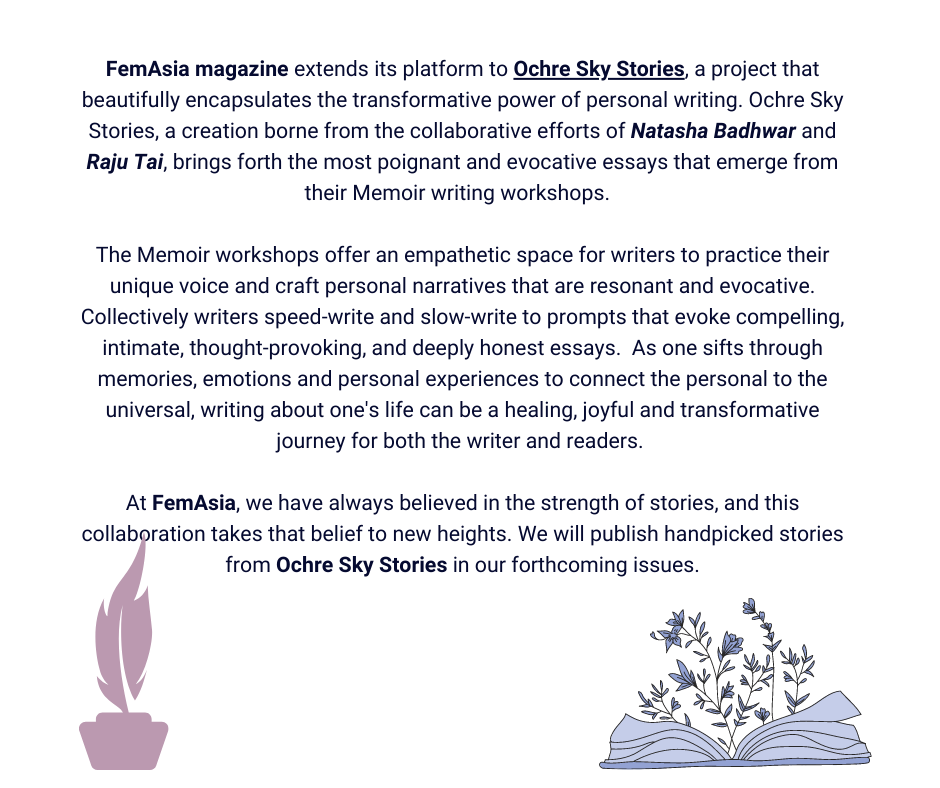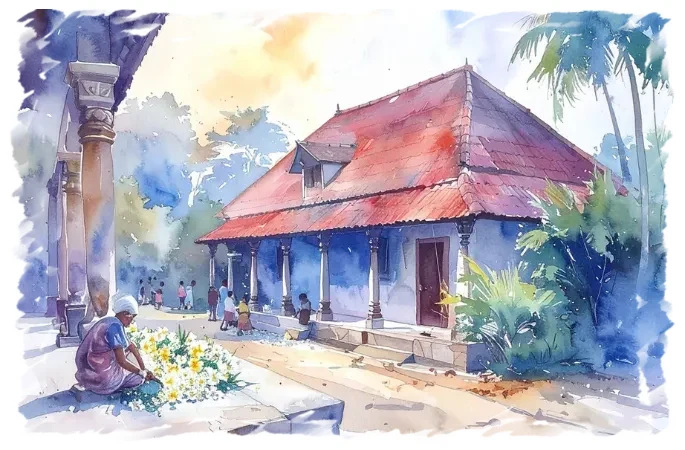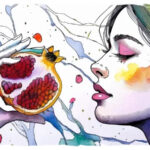There are some sights and smells that hit a rewind button in your mind and your body responds to it. The sight of a river, the smell of smoke from firewood stoves in a humid part of the country, and the chembakapu (Frangipani flower), take me home, instantly. As a child on vacation, I spent many hours clomping around our homes and the neighbourhood, collecting flowers. This was usually a part of our contribution to funerals and death anniversaries in the family. We were well acquainted with death. Do you remember the moment in your childhood when you learned that people were mortal? I don’t. Did we just know? Did the first death just happen around us, and we connected the dots from the conversations adults were having?
During our annual visits home to Pala, the biggest gatherings of people we saw were for funerals. Long, long processions of people walking from the church to the cemetery. The nuns piled into jeeps with loudspeakers, singing in the nasal tone reserved for songs of death.
Thanks for reading! Drop in your email to be in touch!Subscribe
For a few years, death was frequent as it was close. Someone always popped right in the middle of our vacation those years. Consequently, each year, we had a death anniversary or two and usually an unexpected funeral. Aged between 5-15, we were the flower collectors.
The flower collectors fanned out around the mittams and thottams. The youngest ones holding up their T-shirts/frocks /skirts, and the older ones dropping every colourful part of a plant into them. The chembakapu was a child-friendly flower by all standards. The trees were never too tall. If we came upon a grand old tall one, its trunks and branches could usually support the weight of a scrawny young child or bend just enough to let the tallest among us grab its flowers. Its flowers were reasonably sturdy to the touch. Some of us were gentle, others were in a rush, and still others were city-bred, so it took a few funerals before we learned the subtle art of plucking a flower without bruising it.
The gentle and generous “Y”s and “V”s of the chembakam’s trunk and branches made it the first choice for little children to try and scale. My favourite variety was the very common white one with a gentle dusting of yellow at the centre. We also had pink (very suspicious-looking) and mellow yellow varieties. The ones around our homes had a heady fragrance.
The flower collection drives amidst deaths were a blessing for the children. We did not have to stand and watch helplessly as adults wept. Not that as children, we did not sense the grief or experience it ourselves, but we all had plans for the vacation, and death was a bit of a spoiler. Till it came too close, and then too the children of course bounced back faster than the adults.
These excursions kept us from being inappropriate. They also took our minds off the loss and gave us an excuse to run wild and feel important. Our usual pastime of playing cards would have been terribly disrespectful of the dead, and the laughing and guffawing that came with it wouldn’t help. So, the pre-ritual hours of gathering flowers were our time to be free from censure.
Once we brought the collection home, we’d huddled up on the thinna and discussed ways of arranging them. Weaving garlands was too time-consuming, and our skills with a needle and thread were limited. After a couple of attempts, the stem and flesh of the flower would shred, and flowers would drop off the loop. Over time, with unfortunately many occasions to practice, we found the most practical solution. Eerkillis -midribs of the coconut palm leaflet, usually used in brooms. Threading chembakapus onto an eerkilli and laying these mini flower towers in the coffin or the grave, and we were all set. The other blooms were scattered to complement these soldiers. We thought about what the person would have liked and made up their preferences when we didn’t know for sure. The jasmines should be close to baby Jasmine’s heart we must’ve said, as we decorated the coffin of our 5-year-old cousin.
Parallel to the flower collectors another important figure at funerals was the photographer. Alongside the newspaper announcements of the death, booking the church service and priest’s time, booking a photographer was important. Much like at weddings (in the pre-wedding photo shoot era), photographers here too were seen as necessary. As people bent to kiss their loved ones, flashes and clicks would keep time with the hymns. Before leaving the house, close family and friends lined up beside a coffin to be photographed. When it was our turn, we had to be appropriately solemn. I remember being anxious about being caught on camera with a smile or looking anything less than morose. I never found this odd. It just was the way things were done.
When the adults noticed the flower work in the coffin or around the grave, some of the kind ones would appreciate the hard work put in by children. We’d mumble the oppees (prayers for the dead) multiple times over with nuns, priests, and their affiliates and the large crowds that would have gathered. The oppees is the first lengthy prayer I learned in my mother tongue.
When the pain had subsided in a couple of days, the playing cards would be brought out, and riotous laughter and shrieks would push a semblance of normalcy back into our homes. The prudes would hush us and the ones with the deepest grief wouldn’t be bothered. I wonder how deafening the post-vacation silence must have been. The absence of the dead may have finally made its presence felt, and a new normal would be setting itself up. Then, 10th-day anniversaries, one-month anniversaries, and other occasions would call for flowers. The search perimeter would have shrunk with fewer pairs of scrawny legs to collect them on demand. Till the next summer vacation.
The last time death came very close was when my ex-husband’s father suddenly passed. We were from different religious and cultural backgrounds. As we packed to rush home, he was puzzled to find me reaching for the camera. I was on autopilot, the conditioning from my childhood kicking in —‘how to be useful.’ We came home to Papa, stretched out on the floor in white. Amidst my own tears, I sat on the floor and took pictures while he held his mother. I have never looked back at those funeral photographs from my childhood; why then was I performing this hideous role no one had asked for? I didn’t know what else to do. The flowers were already there, the loss was permanent, and regrets and missed opportunities were beginning to string themselves together—there were no mittams and thottams to be lost in. To ma’s credit, she just let her weird new child be. She always did.
For any of you facing loss. I hope you find gardens to get lost in. To gather flowers to decorate your grief. Don’t carry a camera though. That’s just a strange thing we did.
This work was written during the Ochre Sky Memoir writing workshop facilitated by Natasha Badhwar and Raju Tai.




